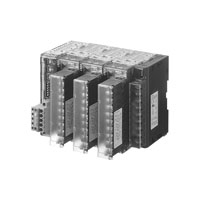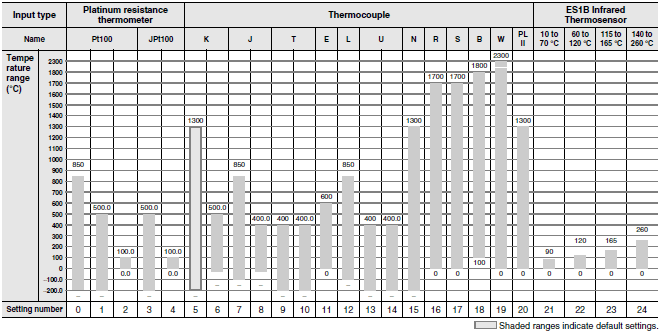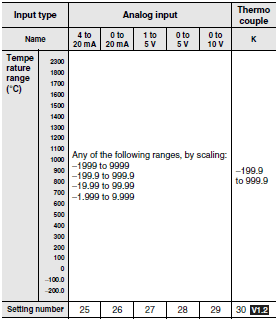| Type | EJ1N-TC4 | EJ1N-TC2 | |
|---|---|---|---|
| Power supply voltage | 24 VDC | ||
| Operating voltage range | 85% to 110% of rated voltage | ||
| Power consumption | 5 W max. (at maximum load) | 4 W max. (at maximum load) | |
| Input * | Thermocouple: K, J, T, E, L, U, N, R, S, B, W, PLII
ES1B Infrared Thermosensor: 10 to 70°C, 60 to 120°C, 115 to 165°C, 140 to 260°C Analog input: 4 to 20 mA, 0 to 20 mA, 1 to 5 V, 0 to 5 V, 0 to 10 V Platinum resistance thermometer: Pt100, JPt100 |
||
| Input impedance | Current input: 150 Ω max., voltage input: 1 MΩ min. | ||
| Control
outputs |
Voltage
output |
Output voltage: 12 VDC ±15%, max. load current: 21 mA (PNP models with short-circuit
protection circuit) |
|
| Transistor
output |
--- | Max. operating voltage: 30 V, max. load current: 100 mA | |
| Current
output |
--- | Current output range: 4 to 20 mA or 0 to 20 mA DC
Load: 500 Ω max. (including transfer output) (Resolution: Approx. 2,800 for 4 to 20 mA DC, approx. 3,500 for 0 to 20 mA DC) |
|
| Event
inputs |
Input points | --- | 2 |
| Contact input | --- | ON: 1 kΩ max., OFF: 100 kΩ min. | |
| Non-contact
input |
--- | ON: Residual voltage: 1.5 V max.,
OFF: Leakage current: 0.1 mA max. |
|
| Event inputs | --- | Outflow current: Approx. 4 mA per point | |
| Number of input and
control points |
Input points: 4, Control points: 4 | Input points: 2, Control points: 2 | |
| Setting method | Via communications | ||
| Control method | ON/OFF control or 2-PID (with autotuning, self-tuning) [V1.2] | ||
| Other functions | Two-point input shift, digital input filter, remote SP, SP ramp, manual manipulated variable,
manipulated variable limiter, interference overshoot adjustment, loop burnout alarm, RUN/ STOP, banks, I/O allocations, etc. |
||
| Ambient
temperature range |
Operating: -10°C to 55°C, Storage: -25°C to 65°C (with no icing or condensation) | ||
| Ambient humidity range | Operating: 25% to 85% (with no condensation) | ||





